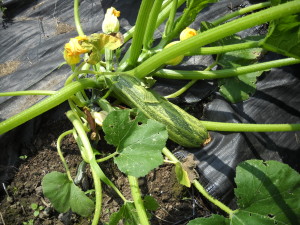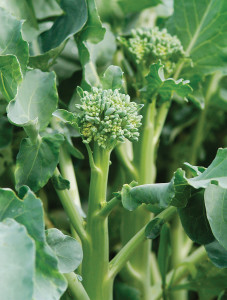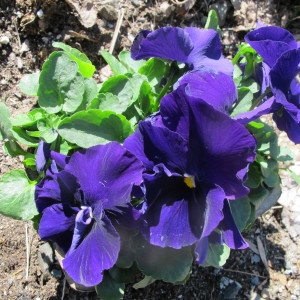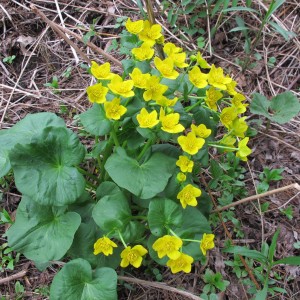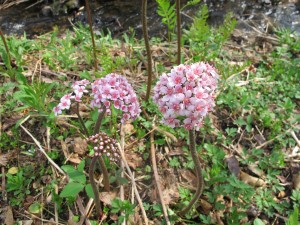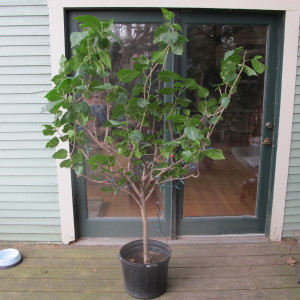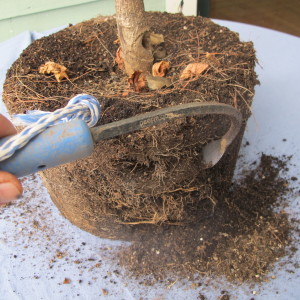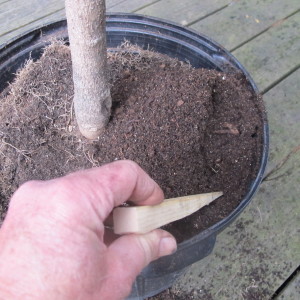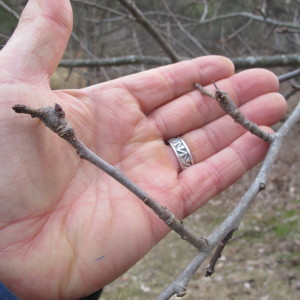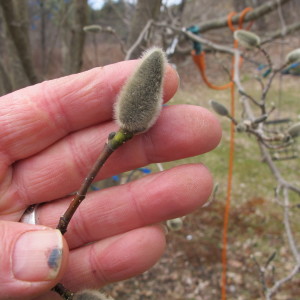Tips on Growing Vegetables, A to Z
It’s time to start thinking about the vegetable garden. We had frost recently, and will again, but this is a good time to think about what to plant. I can’t cover all plants I will grow – or have in the past – but I’d like to share a few tips on plants I love, starting with artichoke and going to zucchini.
Twenty years ago it was unheard of to grow artichokes in a New England garden. The first time I grew an artichoke from seed it developed into a huge plant, but didn’t start to produce “chokes” until cold weather came in the fall. So I built a little plastic-sheathed hoop house over it, and harvested my one and only artichoke in October – after snow! The local paper sent a reporter and a photographer.
Here’s what I’ve learned since that first effort: start early. I planted seeds March 3 this year in 6-packs and transplanted seedlings into bigger plastic pots in mid-April. Now the plants have 4 large leaves, and are ready to go to my cold basement (45 degrees) where I will set them up under lights on a timer, giving only 10 hours of light per day for the next10 days. This will fool those poor artichokes into thinking they have gone through a winter. Artichokes, you see, usually only produce in their second year. I’ll plant mine outside in early June. In California, artichokes are perennial – though I’ve never succeeded in overwintering them here.
Now locally grown artichokes are sold at farm and seedlings are sold, too, in case you haven’t started any. They will produce lovely foliage plants – and a few small artichokes. Some farms grow them in unheated greenhouses to stimulate them to produce their first year.
“B” is for beans. There are many varieties; all can be placed in one of two categories: bush beans or pole beans. Bush beans produce a nice yield of beans over a 3 to 4 week period, and are done. Pole beans, once they start producing, will continue to produce some beans until fall – if you keep picking them. Not only that, pole beans are better for casual gardeners, as many varieties still are yummy even if the beans are not picked on time and get large. Bush beans that get large, get woody. My favorite pole bean is ‘Kwintus’ from Cook’s Garden Seeds. ‘Kentucky Wonder’ is also great, and available everywhere.
Beans are legumes, and have nodules in their roots that can harbor nitrogen-fixing bacteria. These bacteria take nitrogen from the atmosphere and fix it in the soil – transforming it into nitrogen useable by plants. Free fertilizer, if you will. You can buy a packet of inoculant at garden centers. Wet your beans at planting time, then sprinkle the inoculant on the beans, and plant. A packet of inoculant will do a lot of beans, but won’t work next year, so share your leftovers with another gardener. And if you don’t get any in time, you can sprinkle it over the soil and water it in.
“B” is also for broccoli. I start mine by seed, but it’s getting a bit late for that now if you want early broccoli. But it is plentiful at garden centers, and quite cold-tolerant once hardened off and well established. You can plant seeds outdoors by seed in mid-July for a fall crop.
My favorite broccoli substitutes are two relatives that don’t ever produce a big head, but are quick-growing and produce very numerous mini-heads, what we would call side-shoots on broccoli. One is called piracicaba, and is available from Hudson Valley Seed Library (www.seedlibrary.org). It’s actually a tropical broccoli, so does well in the heat so summer when many others are feeling wilted and sad.
The other is Happy Rich, a hybrid sold by Johnny’s Selected Seeds (www.johnnyseeds.com). Like piracicaba, it has a lovely flavor – and you can eat the leaves and stems if you are so inclined. It produces all summer and well into the fall.
The last of the “B” vegetables, for today, at least, is Brussels sprouts. This vegetable is not universally well loved – too many cooks and lunch counters over cook it, serving mushy sprouts. But they are wonderful if lightly steamed and served with butter or vinegar.
Some gardeners never get big Brussels sprouts because they let the plants grow taller and taller, putting all their energy into growing tall. So here is what you need to do: cut off the top of the plant in early September. Labor Day at 10 am, to be precise. Cut off the top 3 to 4 inches, which is where upward growth occurs. Then the plant will use its energy to create big sprouts.
Skipping forward to “Z” as promised, my favorite zucchini is one called ‘Romanesco’. It has a striped, ridged exterior and firm flesh that is very tasty. What’s wonderful about it is that, unlike many summer squash and other zucchini, the flesh is still tasty and usable even if the squash goes unnoticed and develops into a big fruit.
Romanesco zucchini plants are rarely found at garden centers, but seeds are readily available. Buy the seeds now, plant outdoors in June or early May indoors in 4-inch pots.
Sorry I skipped a few vegetables in this year’s tips, but there will be more in future columns. Meanwhile, I’m going outside to plant some carrots – they come after the “B’s”.
Read Henry’s blog at https://dailyuv.com/
Gardening Gifts for Mother’s Day
When I was a boy, I generally bought my mom some pansies in a little wooden box for Mother’s Day. Mom is long gone, but I’ll be thinking of her and all she did for me when Mother’s Day rolls around on May 8. If your mom is a gardener, or just appreciates the beauty of the living world, there are plenty of good gifts for her.
I like giving pansies for Mother’s day for a number of reasons. First, they are cheerful and full of color. And they are hardy, surviving and thriving outdoors even if we get frost. And they look good even without wrapping paper (I am still challenged when it comes to wrappping).
Each pansy plant is relatively small at the beginning of the season, but they will give a nice punch of color even while they are bulking up. Pansy grower Jenny Wright of Unity, NH tells me that pansies “…would rather be in England where it is cold and rainy.” So later, in August, they tend to sulk until fall rains come.
Perennials are good gifts, too. Right now some of my hellebores are blooming. Don’t know hellebores? You should. These early-spring beauties have evergreen leaves and come in a variety of colors from white to pinkish to shades of purple or even green, both as singles and doubles (with extra petals). Hybridizers have been developing new colors because they are relatively fool-proof plants.
Hellebores are plants that do fine in shade, or partial shade. They prefer moist, well-drained soil but will do fine in dry shade, too. In the beginning of spring the evergreen leaves on hellebores look pretty ratty. I’ve cut those back to tidy up the bed, and I see that new leaves are already unfurling. I’d say that by May 1 the hellebores will be looking dramatic.
Another early spring flower that will look good on Mother’s Day has a rather unappealing common name, lungwort. I prefer to call in by its botanical name, the one used by scientists, Pulmonaria. There are actually three species of Pulmonaria but all are very similar. Cold hardy to minus 40 Fahrenheit, they grow in full to partial shade in ordinary garden soil of moderate fertility, but don’t do as well in a very dry location.
Pulmonaria is a good groundcover, one that stays relatively low and spreads by root. The flowers can stand up above the leaves to 8 to 12 inches, but the leaves are low. Most varieties sold have spotted leaves, though I have one, probably Pulmonaria angustifolia, that does not. Mine has absolutely iridescent blue flowers that almost seem to light up at dusk or on a cloudy day.
Marsh marigold (Caltha palustris) is a wildflower, but one that is sometimes sold in nurseries. As the name implies, it grows in wet places, even in standing water. It needs a location that is at least moist all year. It is a brilliant yellow flower about 2 inches in diameter. It is hardy to Zone 4, minus 30. It is not related to annual marigolds sold everywhere.
Your mother probably doesn’t have marsh marigolds – most people don’t – so if she has some wet areas near her garden, think about finding one for her. There is a fabulous double variety called ‘Multiplex’ that I planted near my stream last year. I got it at E.C. Brown Nursery in Thetford, VT. The leaves are up, and I can’t wait until the blossoms appear.
Another lesser known plant near my stream is the umbrella plant (Darmera peltata). This blooms in May before the giant leaves appear. It is a native – I have seen it wild along the banks of the Rogue River in Oregon – but it is not native here in the east. The pink flowers appear as drumsticks of florets on a tall stem. The leaves will stand up 2 feet and be 2 feet in diameter later this summer. Available at E.C. Brown Nursery.
I am reluctant to recommend buying a tree or shrub as a gift unless I know the recipient has asked for it. After all, shrubs take up more space than flowers, and generally last longer. But you know Mom best, and if she likes flowering shrubs and has space for more, think about getting the early blooming azalea ‘Cornell Pink’ (Rhododendron mucronulatum).
This shrub blooms before most others (except February Daphne). As the name implies, the blossoms are pink. A nice pink, not garish at all. Its only liability is that it blooms so early that some years a hard frost can ruin the buds, I’m told. It’s never happened to me, or to anyone I know, but the literature always warns about it. The shrub can get large – 8 feet tall and wide, or larger – if not pruned.
If you’d rather not buy plants, think about other things useful to a gardener. A CobraHead weeder (www.cobrahead.com), some nice garden gloves, or perhaps a colorful tubtrug. Trugs, as I call them are handy bucket-substitutes. Unlike the standard 5-gallon pail, these are flexible with 2 soft handles. Easy to pick up with one hand, they come in sizes from very small to quite large (11 gallons). Available at Gardeners Supply (www.gardeners.com), or your local garden center.
Mom, if you’re watching me, I planted some pansies this week. I hope you like them.
Henry Homeyer is blogging at https://dailyuv.com/
It’s Time to Re-Pot Many Houseplants
Plants are smarter than you think. It’s true that most have a hard time remembering their nine-times tables, and are darned if they know the capitol of Nebraska (though even I might need help from Mrs. Google on that). But, for example, they know spring is on the way – even if they haven’t been outside.
When spring arrives the sun coming in the window is stronger, days are longer, and plant roots are growing. Plants know it’s time for some special care – bigger pots and more water. If you haven’t repotted any houseplants in recent years, you might want to do so now.
There are two schools of re-potting. Some good growers say, “don’t mess with the roots. Just put the plant into the next bigger sized pot, and let its roots find their way into new soil”. The other school of growers say, “tease out the roots and cut them back to encourage them to divide and grow new roots”. I’m in the second school. Especially for large plants that are already in big pots.
I have a hibiscus plant, a small tree, really, that was given to me more than a decade ago. It came in a cheap plastic pot about 14 inches in diameter, and a foot or so deep. Up until very recently it’s been in that same pot. The plant is 6 feet tall, decorated with lights, and blooms regularly – and has for years. This winter blossoms were scarce, so I decided that it was time to give it some new soil, compost and fertilizer.
Over the years my hibiscus has lost a lot of soil – until I re-potted it, the soil surface was 4 inches below the top edge of the pot. Some washed out with watering. Some was taken up by the plant. And some organic matter just oxidized and disappeared. That’s right, organic matter in soil can “burn up” and disappear with time –whether in your garden or in a pot. It’s why adding compost to the soil every year is standard practice in the vegetable garden.
Some big indoor plants develop big, fat roots that encircle the pot if not re-potted. When re-potting those, I get out my root knife or scissors and cut back the roots. Not so this one. It has small, fibrous roots. I teased out the roots with my CobraHead weeding tool and tickled them loose with my fingers. I let the tired old soil fall away.
To re-pot that hibiscus, I slid it out of the pot and placed it on an outdoor table on an old sheet. I removed about half an inch of soil all around the root ball, and even more on the bottom. I cut back the few long roots I came across. Then I measured the root ball. It was just 8 inches from top to bottom. My pot is 12 inches deep, and I wanted an inch of free space at the top. So I added 3 inches of “soil” to the bottom of the pot and gently packed it down.
The soil mix I used was a 50-50 mix of peat-based commercial potting mix and a fluffy light compost I buy by the truckload for my outdoor gardens. I ended up using12 quarts of this mix. I added about a cup of Pro-Gro brand organic, slow-release fertilizer to the bucket of planting mix. And I added half a cup of green sand, a naturally-occurring product that contains potassium and lots of trace minerals. It is mined in New Jersey from what was once an undersea deposit.
After teasing out the roots I placed the root ball back into the pot and filled the space around the edges with my soil mix. I used my fingers and a piece of kindling – a wedge-shaped board that could get almost to the bottom of the pot – to push the mix down the sides of the pot.
Finally, I gave my re-potted hibiscus a good long drink of water. To the water I added Superthrive, which touts itself as “the original vitamin solution.” It contains seaweed extracts and plant hormones, and is very good for stressed plants. It’s very concentrated: half a teaspoon in 2 quarts of water made a very good boost for my plant. I’m a firm believer in the value of Superthrive.
If you’ve been paying attention, you know that most houseplants need more water now than they did in December. Take rosemary, for example. If you brought in your rosemary plant last fall, you probably got into a rhythm: water it every Sunday before church. Or Wednesday after bowling. Or whatever. But you knew it needed the same amount of water every week.
Then, all of a sudden, you might have noticed your rosemary was super dry. In fact, you might have noticed that it was dead. I’ve lost more rosemary plants in March and April than at any other time. A totally dry rosemary is a dead rosemary. So if yours is still alive, double the watering!
Come summer, you’ll probably bring many of your houseplants outdoors. I know I will. So I’ve started bring a few out for a little direct sunshine. By slowly introducing them to sunshine now, they are less likely to get sunburned when they move out full time. An hour or two a day is a good re-introduction to the sun.
Oh, and by the way, the capitol of Nebraska is Lincoln, not Omaha. I know. My hibiscus told me.
Read Henry’s blogs at https://dailyuv.com/
Forcing Shrubs to Bloom – Now!
I don’t know about you, but I am more than ready for spring blossoms. My little bulbs like snowdrops are blooming already, but I want my magnolia, crabapples, forsythia and daphne to bloom, too. Fortunately, I can easily speed up the process –indoors. Here’s what I’m doing.
I have cut branches with flower buds and brought them inside to force them in a vase of water. It’s important to know what to look for when you cut branches to force.
Let’s start with apples. What you need to cut are older branches with little stubby outgrowths on them. Those stubs are called fruit spurs, and if they are at least 2 years old, they should produce flowers and as well as leaves. Most apple trees also create pencil-thin straight new shoots each year. These are called water sprouts and will not produce blossoms in a vase, only leaves. Sometimes I pick water sprouts, too, as even leaves are pleasant in early spring.
Fruit spurs most often are produced on branches that are growing at a 30 to 45 degree angle to the trunk or a main branch. Some young trees tend to be very vertical, sending most branches virtually straight up. If you bend a vertical branch to a broader angle, it will often develop fruit spurs in a year or two. Just tie it in place from now until early June and it should stay at the new angle.
An apple fruit spur produces not one flower, but a few, and leaves, too. Just put the branches in a vase of water in a sunny window. In a week or more the branches will burst open with blossoms. When I prune fruit trees, including apples, crabapples and pears, I regard the branches carefully and pick those most loaded with fruit spurs to bring into the house.
Some 20 years ago I planted a small magnolia in my back yard in the middle of an open lawn. Over the years it has reached full size – perhaps 25 feet tall and nearly as wide – and it blooms reliably on my birthday in late April. I have already cut some branches and put them in a vase, and they will bloom indoors within a week or so.
My magnolia is a ‘Merrill’ hybrid. It is a perfect 4-season plant. In the spring mine has more than a thousand 4-inch, lightly fragrant blossoms. In the summer it has glossy green leaves, and no pests. In the fall it displays colorful seeds and bright yellow foliage. In the winter the buds that will open in spring look like pussy
willows on steroids. And it is growing in moist soil near a stream, a location where many trees would not thrive (many do not like wet feet) . Other than the ancient, stately maples on my property, it is my favorite tree.
Then there is the forsythia, one of the earlier things to bloom in our part of the world. For decades gardeners in northern New England grew old fashioned varieties of forsythia and got blossoms low on the bushes, but not above the snow line. Flower buds on any early-blooming shrub are formed the summer before, and must survive the cold temperatures and winds of winter. Those forsythia buds were not hardy in my zone.
But all that has changed. There are now varieties that are fully hardy in Zone 4 – where temperatures drop to minus 30 degrees Fahrenheit each winter. Prime among them are New Hampshire Gold (developed in my home town of Cornish, NH by the late Paul Joy), Vermont Sun, Meadowlark and Northern Gold. These bloom everywhere. When cutting stems for blossoms, pick vigorous young stems. By now you should see some hints of gold in the buds on those branches.
I‘ve been growing a tidy shrub called February Daphne for a dozen years or so. Its proper botanical name is Daphne mezereum. I love this plant so much that when I got a corgi puppy 10 years ago, my first AKC registered dog, I named her Daphne Mezereum. Of course I call my wonderful dog Daffy (except when she rolls in nasty stuff, when I may use her full name to reprimand her).
February Daphne may bloom somewhere in February – New Jersey, the garden state, for example – but for me it blooms in April. Early April if the weather is mild, like this year. I picked some recently and the buds, nearly open, popped open almost immediately.
The rule of thumb is this: the closer you are to the outdoor bloom date, the quicker a branch will bloom in the house. Lilac, which is still many weeks from blooming for me, will not quickly or easily force in the house now. A week before those buds open? Piece of cake.
On another topic, an important one for gardeners, is the presence of deer ticks in the garden. I recently researched deer ticks and the diseases they carry, including Lyme disease. Ticks are already out and biting. If you wish to go on-line, you can see my piece that gives 7 ways to prevent Lyme disease, along with photos of the ticks. Just go to https://dailyuv.com/
Henry is a UNH Master Gardener and the author of 4 gardening books. He lives and gardens in Cornish Flat, NH. His web site is www.Gardening-Guy.com.



